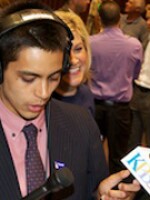Most days, Gabriel Romero can be found in his small Tijuana workshop, surrounded by scraps of wood, crafting a small instrument that looks like a guitar, but is smaller, and with eight strings. It’s called a jarana.
Until recently there were no luthiers who made them in Tijuana. But Romero, having started his workshop in October, is now at least the third artisan of the instrument to open up shop here.
The reason: Son Jarocho – that southern musical style – is thriving in Tijuana and San Diego.
Son Jarocho is a vibrant music with Caribbean, indigenous, and African roots. It’s played at gatherings called fandangos, where musicians stand around a wooden platform with their jaranas, and take turns singing and stepping onto the platform to dance.
Fandangos have been a way of life in rural Veracruz for centuries. But more recently, they’ve gained popularity in cities, both in Mexico and in the U.S.
Here along the border, the communal jam sessions are bringing Mexicans and Mexican-Americans from both sides together in people’s living rooms and backyards, at parks, and even at the international boundary, where each summer musicians organize a fandango held on both sides of the border fence.
The music is enjoying a special surge of popularity among young Mexican-Americans, who are embracing it as bridge to cultural roots in Mexico despite their nationality.
Ofelia Peon lives in Chula Vista and recently stumbled upon the music by chance when she visited Tijuana and saw a few people playing jaranas on a plaza.
“This is what I’ve been looking for!” she remembers exclaiming. She recently bought one of Romero’s jaranas.
He hosts fandangos at his home in Tijuana, but himself has only been playing for five years. He was introduced to the music by a friend from San Diego, who herself learned from her sister in Los Angeles, where the Son Jarocho scene is especially large. Zamudio now teachers others in Tijuana and San Diego how to play the jarana.
He said that's the interesting thing about this musical movement, the way it’s spreading almost by word of mouth, and larger numbers of young urban Mexicans and Mexican-Americans discover it.
“Son Jarocho is like a tree, which sprouts a branch, which sprouts leaves, and just keeps getting bigger,” Zamudio said.
In San Diego, one of the main figures cultivating Son Jarocho is Eduardo Garcia.
He holds monthly fandangos at his home, and free workshops where he teaches beginners, many of them young Mexican-Americans.
He attributes the music’s growing popularity to the community that forms when musicians of all skill levels are welcomed to stand together and play what is fundamentally a roots music.
“It’s a welcoming music,” Garcia said. “You can participate in a fandango, even at the margins of it, if you know the basic stuff.”
And he said that’s why this rural music has become so appealing to young people in cities and in the U.S. The sense of community that fandangos foster is a trait of the rural towns where the music originates, but he thinks that’s been lost in many urban areas, and Son Jarocho is allowing people to rediscover it.
He likened the fandango to a campfire, “that is in the middle of nowhere, on the side of a mountain,” that can provide a point of reference for people searching for that community.
That’s why he enjoys teaching others, he said. “There is a need to keep that fire burning, always."







